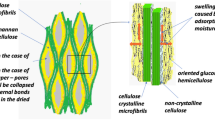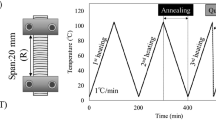Abstract
The viscoelastic properties of mod were investigated using dynamic mechanical thermal analysis and differential scanning calorimetry. Under a limited set of conditions, two separate glass transitions (T g) could be identified with both techniques. These two transitions were identified as arising from the amorphous lignin and hernicellulose matrix in the wood cell wall. Moisture dramatically affected the temperature at which the two dispersions occurred and, consequently, the ability to resolve their independent responses. The relationship betweenT g and moisture for both components could be modelled with the Kwei equation, which accounts for the presence of secondary interactions. Annealing and specific interactions of a series of organic diluents were wed in an attempt to enhance the resolution of the two components values ofT g. Time-temperature superposition was shown to be applicable to wood plasticized with ethyl formamide, following Williams-Landel-Ferry behaviour over the temperature rangeT g toT g + 85° C. These observations allow certain conclusions to be drawn concerning the applicability of existing models of the wood cell wall's supermolecular morphology. Most notably, models of thein situ morphology of the three wood components can be limited to those which consider the amorphous matrix of lignin and hemicellulose to be immiscible.
Similar content being viewed by others
References
H. Schniewind,Wood Sci. Tech.2 (1968) 188.
J. Bodig andB. A. Jayne, “Mechanics of Wood and Wood Composites” (Van Nostrand Reinhold, New York, 1982) Chs 5 and 6.
M. Mori, M. Norimoto andT. Yamada,Wood Res.56 (1974) 33.
W. E. Hillis andA. N. Rozsa,Holzforschung32(2) (1978) 68.
W. J. Cousins,Wood Sci. Tech.10 (1976) 9.
Idem, ibid.12 (1978) 161.
G. M. Irvine,TAPPI67(5) (1984) 118.
T. Hatakeyama, S. Hirose andH. Hatakeyama,Makromol. Chem.184 (1983) 1265.
D. A. I. Goring,Pulp Paper Mag. Can.64 (1963) t517.
R. A. Young,Wood Sci.11(2) (1978) 97.
N. L. Salmen andE. L. Back,TAPPT60(12) (1977) 137.
N. L. Salmen,J. Mater. Sci.19 (1984) 3090.
C. A. Wert, M. Weller andD. Caulfield,J. Appl. Phys.56 (1984) 2453.
T. Sadoh,Wood Sci. Tech.15 (1981) 67.
E. L. Back andN. L. Salmen,TAPPT65(7) (1982) 107.
L. Salmen, E. Back andY. Alwarsdotter,J. Wood Chem. Tech.4(3) (1984) 347.
R. F. Eaton, T. H. Tran, M. Shen, T. F. Schatzki andE. Menefee,Polym. Prepr.17(2) (1976) 54.
T. K. Kwei,J. Polym. Sci.: Polym. Lett.22 (1984) 307.
I. M. Ward, “Mechanical Properties of Solid Polymers”, 2nd Edn (Wiley-Interscience, New York, 1983) Chs 5 to 8.
E. A. Turi, “Thermal Characterization of Polymeric Materials” (Academic Press, New York, 1981) Chs 2 and 4.
J. Gravitis andP. Erins,J. Appl. Polym. Sci.: Appl. Polym. Symp.37 (1983) 421.
P. Erins, V. Cinite, M. Jakobsons andJ. Gravitis,ibid.28 (1976) 1117.
T. G. Rials andW. G. Glasser,J. Wood Chem. Tech.4(3) (1984) 331.
J. Halpin, in “Composite Materials Workshop”, edited by S. W. Tsai, J. C. Halpin and N. J. Pagano (Technomic Publishing Co., Stamford, Connecticut, 1967) p. 87.
A. R. Schultz andA. L. Young,Macromolecules13 (1980) 663.
C. Skaar, “Water in Wood” (Syracuse University Press, Syracuse, 1972) p. 57.
E. L. Schaffer, in “General Constitutive Relations for Wood and Wood-Based Materials” (Syracuse University Press, Syracuse, 1980) p. 254.
A. Rudin, “The Elements of Polymer Science and Engineering” (Academic Press, New York, 1982) p. 433.
H. Burrell, in “Polymer Handbook”, 2nd Edn, edited by J. Bandrup and E. H. Immergut (Wiley-Interscience, New York, 1975) p. IV-337.
W. J. MacKnight, R. E. Karasz andJ. R. Fried, in “Polymer Blends”, Vol. 1, edited by D. R. Paul and S. Newman (Academic Press, New York, 1978) p. 224.
M. L. Williams, R. F. Landel andJ. D. Ferry,J. Amer. Chem. Soc.77 (1955) 3701.
J. J. Aklonis andW. J. MacKnight, “Introduction to Polymer Viscoelasticity”, 2nd Edn (Wiley-Interscience, New York, 1983) Ch. 3.
B. L. Lenz,TAPPI51 (1968) 511.
H. Ishikawa andT. Nakajima,J. Jpn. Forestry Soc.36 (1954) 104.
W. Brown,J. Appl. Polym. Sci.II (1967) 2381.
Author information
Authors and Affiliations
Rights and permissions
About this article
Cite this article
Kelley, S.S., Rials, T.G. & Glasser, W.G. Relaxation behaviour of the amorphous components of wood. J Mater Sci 22, 617–624 (1987). https://doi.org/10.1007/BF01160778
Received:
Accepted:
Issue Date:
DOI: https://doi.org/10.1007/BF01160778




